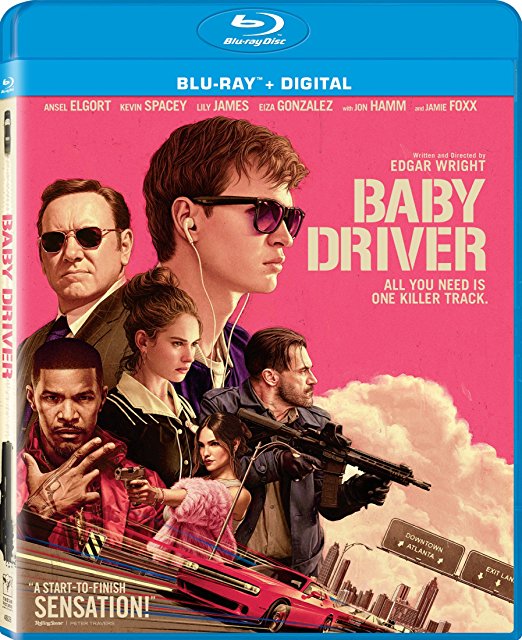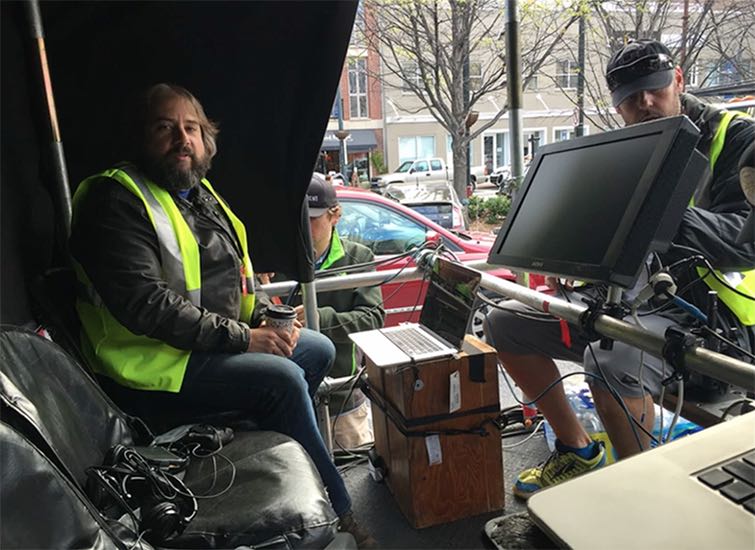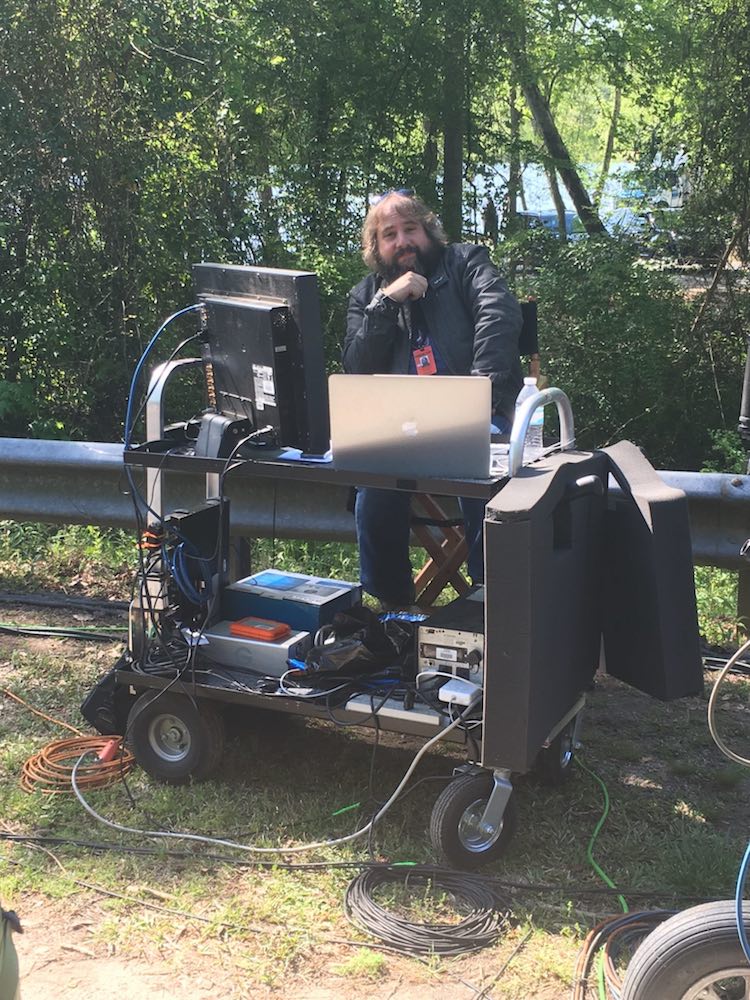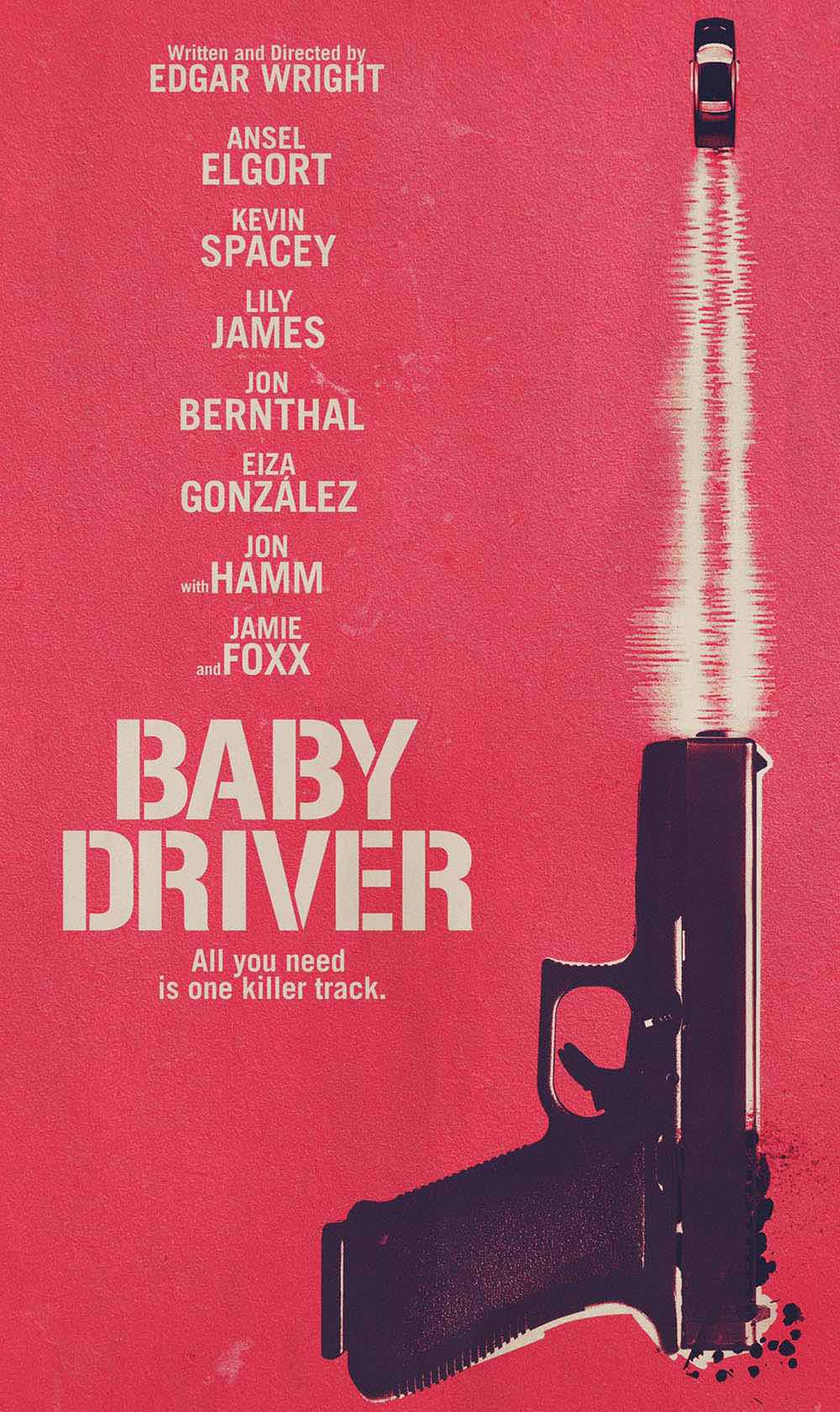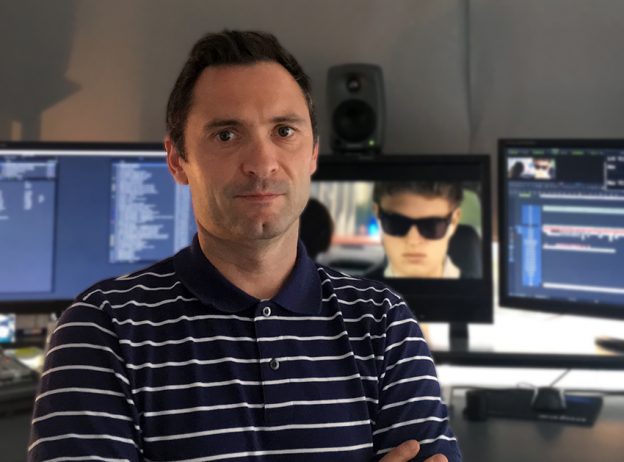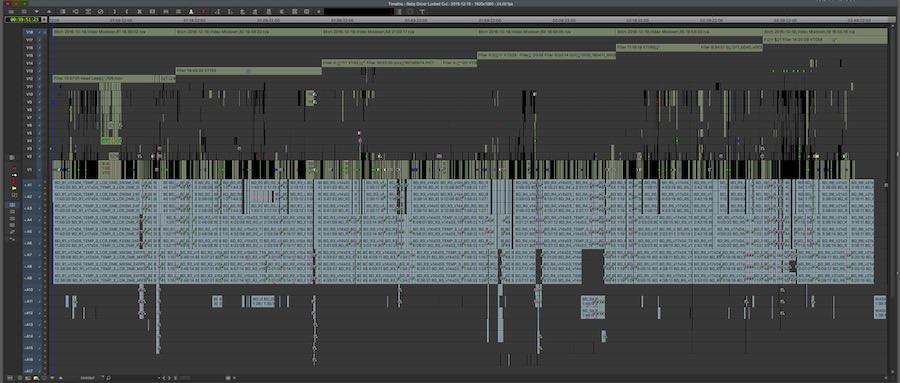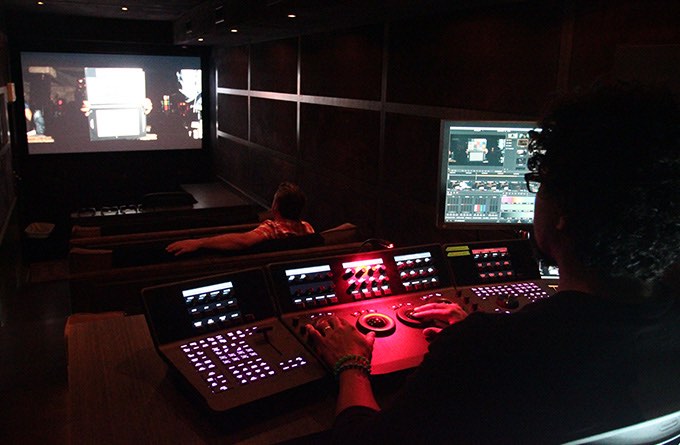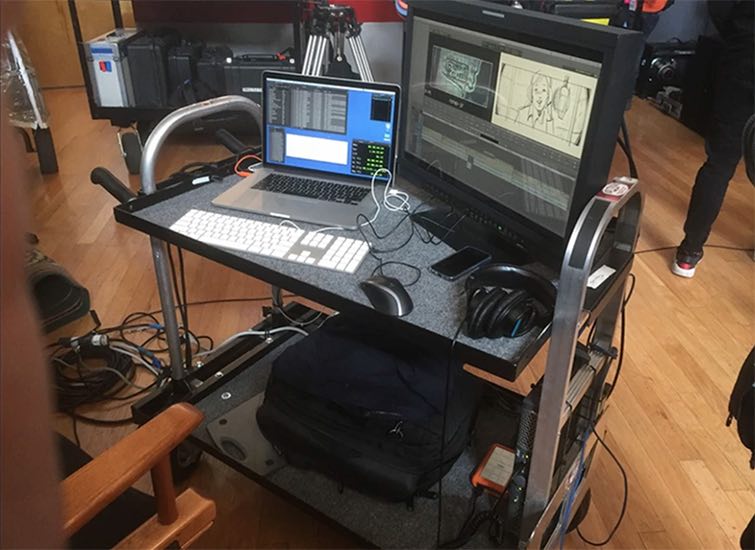Editing Baby Driver – Beat Driven Heists
I really enjoyed Baby Driver. I loved the choreography, the characters and the car chases. It’s a great movie that’s just trying to be, and is, a lot of fun.
It also has some unique characteristics when it comes to it’s post production workflow that I thought would make for an interesting round up.
UPDATE – Baby Driver is out on blu ray and DVD for only [amazon_link asins=’B073BXVX2J’ template=’PriceLink’ store=’jonelwfiledi-20′ marketplace=’US’ link_id=’2050f58c-0cc4-11e8-b18c-37998b2a430e’]. I’ve got the UK release and it’s got some pretty decent extras on it which include:
- 20 minutes of extended and deleted scenes
- Mozart in a Go-Kart: Ansel Drives
- Original Animatics
- I Need a Killer Track: The Music
- That’s my Baby: Edgar Wright
- Find Something Funky on There: The Choerography
One of the first things I heard about the film that intrigued me was that the director (Edgar Wright) and some actors recorded a table read, well before production was financed, which editor Paul Machliss cut together ‘in his spare time.’
This was embellished with all of the pre-cleared music tracks, sound effects and other things such that executives and financier’s could effectively listen to the film before they’d shot any of it.
Another interesting element was the extensive use of pre-vis which was essential to the choreography of not only the action sequences but the musical match up too. As a result of this Paul was on set for every single day of shooting, sometimes riding along in the camera car with his laptop, cutting as they shot.
[As a quick aside this is something editor Walter Murch likes to avoid, as he prefers the baggage free freshness that comes from viewing the material at a distance to the effort required to create it, and much more like a movie going audience would.Paul has this to say about that: “Some editors don’t like being on set, but I like the openness of it – taking it all in. Because when you are in the edit, you can recall the events of the day a particular scene was shot – ‘I can remember when Ken Spacey did this thing on the third take, which could be useful’.“]
There are two editors credited on the film, Paul Machliss and Jonathan Amos who also worked on Scott Pilgrim Vs The World.
Editor Chris Dickens cut Shaun of the Dead and Hot Fuzz.
But before we dive into the details of Baby Driver’s editing here are a couple of fun videos you should definitely watch first…
Remix artist Mike Relm demonstrates his music and video mashup skills on Baby Driver.
Another fun interview that’s well worth a read is this one with Darrin Prescott, the film’s stunt coordinator and second-unit director.
One of the most difficult stunts in the film was what Prescott refers to as the “180 in and 180 out” — a sequence that takes place in an alley during which Fry in the red Subaru getaway car turns forward and backward in a narrow alley and between several vehicles in its path (it’s in the trailer). “He was coming at 70 miles per hour. The buildings were there, the truck was there, it was all practical,” Prescott said. “I had never seen anyone do that stunt before. It was big — and on this movie, we have at least five other major gags.
Darrin also mentions contributing to the animatic with test footage from the stunt practice runs.
If you watch the film with headphones or properly placed surround sound speakers, every time we see Baby in Baby Driver (2017) wearing only one of his headphones, you’ll hear the song he is listening to through that ear only pic.twitter.com/ZeJ9m9IAXm
— Hidden Easter Eggs (@FilmEasterEggs) August 3, 2018
In Baby Driver (2017), the heart in the background while he is getting coffee changes from black to red after he meets Deborah showing that he has fallen in love pic.twitter.com/McQ5l8iz2a
— Hidden Easter Eggs (@FilmEasterEggs) June 15, 2018
Why is Edgar Wright’s Filmmaking Different?
Tony Zhou of Every Frame a Painting is the best filmmaking focused video essayist out there. In this episode he dissects what’s ‘wrong’ with American comedy filmmaking and what Edgar Wright does right.
Tony specifically pulls out eight things, most of which you’ll see him do in Baby Driver too:
- Things entering the frame in funny ways
- People leaving the frame in funny ways
- There and back again
- Matching scene transitions
- The perfectly timed sound effect
- Action synchronised to music
- Super dramatic lighting cues
- Jumping over fences
- Slow-mo gun fights with fingers
Creating Car Chases As Music Videos
In this brilliant re-cap of car chases and scores from Edgar Wright and Sight and Sound, you can get both a grasp of his mastery of film history and the nuances of an awesome car chase.
If you like this, you may well like this previous post on How To Edit Action Movies.
If you want to see how Edgar does it in Baby Driver, Sony Pictures has shared the opening scene, set to the Jon Spencer Blues Explosion’s ‘Bellbottoms’.
This is well worth watching a couple of times to try to catch not only all of the ingeniously edited sync points but also all the movie references scattered throughout.
In this fantastic interview for Rolling Stone magazine, Edgar breaks down a sample of five of the big musical and action sequences in the film. Edgar had this to say about the excellent foot chase:
The studio wanted to cut it. I had to use my own money to pay for two extra days of shooting so we could get it – and it’s my favorite bit in the film. I always thought it’d be great if you made a car chase movie, and then have one of the most explosive scenes in the movie be a foot chase.
The article covers:
- Jon Spencer Blues Explosion – Bellbottoms
- Bob & Earl – The Harlem Shuffle
- The Damned – Neat, Neat, Neat
- Button Down Brass – Tequila
- Hocus Pocus – Focus
Vox has created this nifty little side by side comparison video in which the opening scene’s car chase is mapped out on Google Maps.
This is a rare opportunity to see just how much work the location department has to put in, to find the right locations and tie the sequences all together.
The Tequila trailer is without doubt a snappily edited trailer, that sort of mimic’s the movie, but is actually more like the Suicide Squad trailer, than the way that music is used in the actual film.
It should be pointed out that the actors are listening to the music while they’re on the set, so it’s a combination of booth editing and choreography. It’s being put together with the music in mind on every level.
It’s not like the Suicide Squad trailer, where it’s “Hey, we shot all this stuff, now we’ll edit snippets together to the tune of ‘Bohemian Rhapsody!'”
We constantly piped the music over the sets so people could act to the song.
Interviews with Baby Driver Editor Paul Machliss
In this section of the post I’ve rounded up the best interviews and write ups I could find on the editing of Baby Driver.
The first thing to watch is this recording from Avid’s booth at NAB 2017, in which Matt Feury interviews Paul about what it’s like to edit on set using Media Composer.
It’s about 15 minutes long, but has also been nicely written up in this Premiumbeat.com post, featuring all of the images that Paul shared during the presentation too.
In order to make it work, I had to be there at the moment of creation… I was there every day, at the moment of every take—we had to make sure we got it right.
At that moment, the art of post production actually becomes intertwined with the moment of production—making the cut was just as important as making the take work.
That was probably the hardest job that I’ve ever worked on as an editor, but it’s always exciting to do a job that challenges you and pushes you forward
However one of the most in-depth interviews I’ve seen is this one from StudioDaily.com, which is well worth a read in it’s entirety. The interview covers getting the film financed, the detailed pre-vis work, cutting on set, working with Jonathan Amos and a lot more.
Here is what Paul had to say about the first ‘100 minute radio play version’ of Baby Driver from 2012.
He had mics around the room and recorded a sound file, which he sent over to me.
Over the next couple of months in my spare time, I put this together — we took the table read, the songs and the sound effects, and added extra sound effects and put together, effectively, a 100-minute radio play that was the film without the pictures.
We could give that to potential producers and other executives and say, here’s the film. You can hear it. Now we need to put the pictures on top of it. It was a unique way to sell the film to the studio — we had something tangible. People could put headphones on and become enveloped in the world of Baby Driver before we actually shot a frame.
Here is Paul describing how he and co-editor Jonathan Amos worked together during the actual post production schedule:
When we got back to London, Jon Amos came on board. He and I had a lot of work to do once I returned from Atlanta as the film had to be ready to be shown to the studio by the end of the 10-week director’s cut period.
Jon was mainly responsible for doing a pass on all of the action scenes. He’s incredible at cutting action. So Jon would be looking at the big set pieces that I had assembled on set and had been unable at the time to completely problem-solve, and he made them work brilliantly.
Meanwhile Edgar and I went through from start to finish, concentrated on the story arc, cut the dialogue scenes and weighed up at the film as a whole. And when Jon would complete his sequences, we would drop them back into the main reels.
If you only read one article, read the Studio Daily interview!
If you read two then it’s also well worth reading this detailed interview from Oliver Peters of Digital Films.
I started editing as an online editor… being one of the early London-based Smoke editors. My boss at the time passed along a project that he thought would be perfect for Smoke. That was onlining the sitcom Spaced, directed by Edgar Wright. Edgar and I got on well.
Concurrent to that, I had started learning Avid. I started doing offline editing jobs for other directors and had a ball… [later] I got a call from Edgar, offering me the gig to be the offline editor for the second season of Spaced, because Chris Dickens (Hot Fuzz, Berberian Sound Studio, Slumdog Millionaire) wasn’t available to complete the edit. And that was really jumping into the deep end. It was fantastic to be able to work with Edgar at that level.
Oliver’s interview covers a lot of ground including Paul’s career progression, the use of music, cutting on the set and working as a team later on in the process. It’s well worth a read, especially if you want a few more workflow details:
For me, the speed of working with AMA in Avid in the latest software was a real benefit. I could actually keep up with the speed of the shoot. You don’t want to be the one holding up a crew of 70. I also made good use of background transcoding.
There is an interesting tid-bit in this short interview with Paul, about how detailed he likes to get in his offline sound design, before showing the film to the producers.
Come the start of August when we had to show the film to the studio for the first time it was in a very good state.
I learned from Edgar early on to get it to a really good state before showing it to producers. Let’s make it sound like we want it to sound even though it’s in the offline on the Avid. That helps immeasurably.
You’re hearing backing tracks, atmos, spot effects and if the dialogue’s got to be tweaked we’ll do that too, so we’ll present the studio with as well rounded film as we possibly can.
If you read three articles – and I would recommend that you do! – then definitely check out this Post Perspective article which has quite a few more workflow details not found in other articles.
To assist Machliss during his picture cut, the film’s sound designer had provided a series of audio stems for his Avid. “Julian [Slater] had been working on his sound effects and dialog elements since principal photography ended in Atlanta.
He had prepared separate, color-coded left-center-right stems of the music, dialog and SFX elements he was working on.
I laid these [high-quality tracks] into Media Composer so I could better appreciate the intricacies of Julian’s evolving soundtrack. It worked a lot better than a normal rough mix of production dialog, rough sound effects and guide music.
It also has some of the only comments from editor Jonathan Amos that I’ve seen online too. He talks to his methodology for refining the action sequences.
Amos’ biggest challenge, despite all the planning, was finding ways to condense the material into its pre-determined time slot.
“The real world never moves quite like animatics and boards. We had very specific points in every track where certain actions had to take place; we called these anchor points.
When working on a section, we would often work backwards from the anchor point knowing, for instance, that we only had 20 seconds to tell a particular part of the story. Initially, it can seem quite restrictive, but the edits become so precise.
UPDATE – Baby Driver Avid Timeline and more
Paul Machliss has shared his final Baby Driver Avid Media Composer timeline, in this Avid blog post.
Click through to see the image full size on the Avid site, I’d recommend downloading it to have a decent look at it in full size as it’s a 2549 x 1086 image. You can check out Paul’s use of markers, and see the final edit of the audio and video files which stitched together comprise the film’s 6 reels.
Steve Hullfish continues his excellent Art of The Cut series on Pro Video Coalition with this extended interview with Paul.
You have moments of emphasis. There are fast moments and slow moments. Picture editing also has to be like that. For example in Baby Driver, there’s a scene of Baby and Debora – his girlfriend – in the diner.
Edgar had the whole thing beautifully covered, of course. But there’s a point when she asks him about his mom and he starts to remember her and these powerful emotions play over his face. I didn’t want to cut away.
We had this great tracking shot into him, and even though Debora continues talking and asking him questions, I just stayed on Ansel for a long time – maybe 20 seconds. It felt like the right thing to do. The dynamics of it were right to slow down at that moment.
I showed that cut to Edgar and he loved it. He loved just holding on that shot.
The whole interview is well worth the time as they cover quite a bit of ground, from editing on set to working with audience feedback:
After the first test screening we felt there were a few scenes that could be improved. We felt we could add some more warmth or and have the audience connect better with the characters.
Edgar and I went back in and dug around for some reaction shots and some slightly different readings of lines. Without really changing the dialogue or the story – because we really liked the structure of the scene and the way it played and we didn’t want to change that – we were able to really change the audience perception of the characters based on just a few reaction shots and changes of takes.
UPDATE – Colour Grading Baby Driver and More Post Workflow Details
In what I expect will be the last update to this post, I wanted to include Frame.io’s excellent interview with Paul Machliss that manages to unearth some as yet unmentioned workflow details, covering the edit and delivery process via DCP.
Paul had this to say about collaborating with Director of Photography Bill Pope, during production.
There’s something very nice actually about the DoP and the editor being able to have a constant dialog, as well. We’re always talking on set, and he’s always coming over to review stuff.
Once a week, he, Edgar and Bill would go to the Atlanta offices of Company 3 to watch digital selects streamed from Los Angeles, and do a preliminary grade.
Those grading notes would be sent back to eFilm, where they could begin a more detailed grading process on the rushes. So by the time the digitized rushes were sent back to Paul for editing (usually via Aspera), the film was already pretty close to the look that Edgar and Bill desired.
Well worth a quick read, check out the full interview here.
Paul is interviewed by BAFTA Guru in this nice little interview, in which you get to see and hear from the man himself.
Baby Driver’s Sound Design
If you want a lot more detail on the sound recording that went into the car sound effects – screeching tires, roaring engines and crunching handbrake turns – then check out this post from asoundeffect.com.
Edgar wanted us to hear the world from Baby’s perspective. When Baby is not listening to music his tinnitus is audible to the audience. When Baby gets stressed his tinnitus increases and we also hear that. If Baby pulls out his left earbud to talk to someone then the music in the mix only plays out of the right side of the mix to reflect what he is hearing. It’s a very unconventional mix in that regards.
Julian Slater describes the trio of ‘hats’ he wore whilst working on Baby Driver as the supervising sound editor, sound designer and re-recording mixer.
These clips come from The SoundWorks Collection discussion with numerous members of the sound team, to describe the process of turning Edgar Wright’s sonic harmony into reality.
Cutting Pre-Vis on Baby Driver
Editor Evan Schiff, who I’ve previously interviewed at some length about cutting John Wick 2 and also on how he made the leap from First Assistant Editor to being full-time in ‘the chair’, was kind enough to take the time to answer some of my questions on what was involved in editing Baby Driver’s extensive pre-vis (pre visualisation) footage.
During the Atlanta shoot, Machliss used Apple ProRes digital files captured by an In2Core QTake video assist that was recording taps from the production’s 35mm cameras.
“I connected to my Mac via Ethernet so I could create a network to the video assist’s storage. I had access to his QuickTime files the instant he stopped recording. I could use Avid’s AMA function to place the clip in the timeline without the need for transcoding. This allowed almost instantaneous feedback to Edgar as the sequence was built up.” – Post Perspective Article
In the picture above you can see Paul’s editing cart that he used to remain mobile on the set of Baby Driver, which includes a storyboard from the animatic layer on his first track of his Avid Media Composer timeline, which he referred to all the time.
I had the storyboards running on a lower video layer, because . . . it’s very important to realise in things like this, you can’t do a shot that slightly runs over. Normally you go, ‘Oh, ok, the shot’s about a second longer,’ but when you start to put it together and you start to realise ‘Oh I’m now two and a half seconds out from the music track’ that becomes a problem. – Premiumbeat Article.
Here is my interview with Evan on editing the Baby Driver animatic which would be relied upon throughout the shoot.
When did you come on board and for how long?
I started working with Edgar in July 2014 in order to make a ripomatic he could use in pitch meetings to help sell the idea of the movie and the conceit of having Baby’s world be entirely set to music.
At that point, things like the table read audio and Osymyso mixes of some of the songs were already done and available, so throughout what ended up being a 15-minute ripomatic, we used a little bit of all that stuff, plus over 100 other sources including movies, commercials, and music videos.
After the ripomatic was done, there were a few other videos we did, to help sell some of the key crew Edgar wanted to hire, and show off some of the great music-based scenes from Edgar’s previous movies.
Then in March of 2015 Edgar sent me the first round of storyboards from one of several artists he’d hired to create them, and I cut the storyboards together into animated flipbook-style sequences set to each song, adding in a full sfx mix, visual transitions like wipes and pushes, and anything else that was needed.
For some of the dialogue scenes you didn’t really need a lot of storyboards drawn, so I put in the table read audio to help with timing everything out.
I finished my last bit of work in February 2016, handed off an Avid project with everything I had created to Paul, who had started in Atlanta by that point, and that was pretty much it until I saw the finished film at the LA premiere.
What was the purpose of the pre vis work was it just stunt scenes or other scenes too? Who was watching it?
Since the movie has music from end to end, everything was boarded out. Some sequences naturally had more leeway in terms of matching to the songs than others, but there had to be a proof of concept for everything.
We did cut the storyboards for the action scenes together first, though, since those were the most tightly choreographed parts. Edgar had certain beats in his head where an action had to land on a specific part of the song, and then everything else had to fit in between those 2 or 3 sync points. When I’d send Edgar a new version of a sequence for approval, I would note if I had any problems fitting it all in so we could discuss.
Once there was a production office up and running and department heads had been hired, these storyboard sequences went out to them so they could get an initial idea of what these scenes might require from everyone.
The more everyone was able to see Edgar’s intent for the film and how thoroughly the music would be integrated into it, the better, so I imagine distributing the animatics helped Edgar convey his vision and get his crew on the same page.
Paul Machliss was of course the keeper of a master copy of everything, and I think he cut some straggler storyboard sequences together himself just before they started shooting. I haven’t yet had a chance to find out from him what was useful or not in having these storyboards available once he had actual footage to work with, but from interviews where he’s talked about his process it sounds like they were still useful.
It was always an open question in my mind whether anything I cut together in storyboard form would end up painting Paul into a corner once he had the live shots, but he did such stunning work putting the film together and it seems like he easily dealt with any differences that popped up.
What kind of material were you working with (storyboards, animatics, pre-vis animation?), what makes that easy/difficult?
I was exclusively working with storyboards to cut all these sequences together, but there were 3 storyboard artists that were all sending me versions and updates through different methods.
The artists that drew their boards digitally were the easiest to work with since they could just export individual jpegs that I could bring into Avid quickly. Sometimes I got PDFs with 3 boards per page, and again if they came from a digital source then I was able to easily extract and save them using a batch script in Photoshop.
The hardest boards to work with were the ones that were hand drawn and just sent as full page scans, again with 3 to a page usually. There weren’t too many of those, thankfully, since I had to cut those out one at a time in Photoshop.
I should note the Bellbottoms sequence that opens the film was one that Edgar had commissioned actual previs animation for, so I didn’t end up having anything to do with that section.
Once everything was imported into Avid, it was pretty easy to work with. I do wish Avid would treat imported still frames as lengthless items rather than video, so that you can always trim a still without worrying about running into its head or tail limit, but that’s a minor complaint.
I started by cutting everything into the sequence at its default length of 30 seconds or whatever, with the music underneath and the sync locks off, and then used the Top and Tail functions to do a rough first pass for timing.
It was a bit of trial and error to get the timing right, so sometimes I’d be on a roll and feeling like everything was cutting together perfectly, only to come up on a storyboard that needed to hit a beat 20 seconds later in the music. Or vice versa, where I’d have a bunch of quick edits using up a bunch of the boards, but I’d still hit the next sync point in the song 20 boards too early.
If that happened I’d go back 30 seconds and reassess how I was using my time. I ended up putting markers on the song where Edgar had specified sync points, and I’d put a marker on the corresponding storyboards, and that made it easy to see at a glance on my timeline as I was cutting the sequence down whether I was on track, too early, or too late.
If everything was working perfectly then by the time I got to trimming a board with a marker on it, it would already be lined up with the marker on the audio track.
In some ways, the trickiest part of the whole endeavour was incorporating storyboards resulting from script revisions into sequences I had already cut together. In particular, Hocus Pocus and Brighton Rock had several updates made to them that required re-timing a bunch of beats.
Sometimes the updates would replace existing sections, and sometimes they would just be straight additions, but they would only send the boards that had been changed, so it was sometimes tricky to figure out the best way to conform one into the other.
How detailed was the sound design on the animatic?
It was as detailed as I could make it with the library I had on hand. I have since invested in a new sfx library, but at the time was using an older one where when I’d search for a car sound I’d get nothing newer than a 1992 Honda Civic. I think it still worked pretty well, though.
Using my iPhone with a small external mic, I also recorded my own voice for police radios and TV announcers, as well as a few random sfx I couldn’t find or create otherwise.
For the music, I sometimes mixed the regular track with an Osymyso version if there was one available. Those versions had some sfx already embedded in them, so it saved me a bit of time on that front in cases where the Osymyso version matched up to the storyboards.
Overall it was not a sound mix that would stand up in a theater, but for viewing on a laptop or your phone for reference, it worked great.
Seeing the final film how much was the same and how much had changed?
I never saw the final shooting script, so when I saw the film there were a few story changes I was unfamiliar with, but all the main beats were still there. I think I was grinning ear to ear during Hocus Pocus, though, since that was a long sequence that had gone through multiple revisions, I was very proud of it, and the final film hews very closely to the animatic I cut. Tequila and Brighton Rock were also pretty close to the animatic. It would be interesting to see a side by side of the two some day.
What you working on now or next?
One other thing is that since my work on Baby Driver was spread out over a year and a half, I had a bunch of full-time day jobs editing other movies at the same time as I was cutting the ripomatic and the storyboards.
For the most part I was able to manage having a day job editing a feature and a night/weekend job editing these things for Baby Driver, but it got a bit hairy during production on John Wick 2 to be able to stay caught up on dailies for that film while also getting Edgar what he needed in a timely manner.
I was so excited to be involved, though, and there was no way I was going to let someone else take over, so I made it work during whatever off time I had. Long-distance flights turned out to be great for catching up on storyboards. I’d work the whole flight, and as soon as we’d land I’d turn on my hotspot and upload Quicktimes to Edgar before I was even off the plane.
As for what’s next, I’m currently cutting a Taraji P. Henson film called Proud Mary, due out early next year.
Paul Machliss at Edit Fest 2016
EditFest is a rare opportunity to hear from some of the world’s best editors describe the nitty gritty of their craft, for a whole day.
Paul Machliss was part of the panel of feature film editors, From Dailies to Delivery, during EditFest London 2016.
Here I’ve pulled out the best of what he had to say on the day:
Creativity striking vs 9-5 working days
The Endless Take of Digital Filmmaking
The democratisation of editing/filmmaking tools and how to get into editing (Demonstrate enthusiasm!)
In this video Paul talks about a clip from Scott Pilgrim vs the World and the process of building an animatic before production. Which is something he and Edgar obviously repeated on Baby Driver.
He also covers some other interesting topics from the process of making the film, which was Edgar’s biggest budget to-date. Paul also discusses the editorial discipline required when working on movies with complex VFX shots:
If you don’t hand final shots in, 4 weeks into the shoot, then they won’t be read 18 months from now and you’ll miss the delivery deadline.

